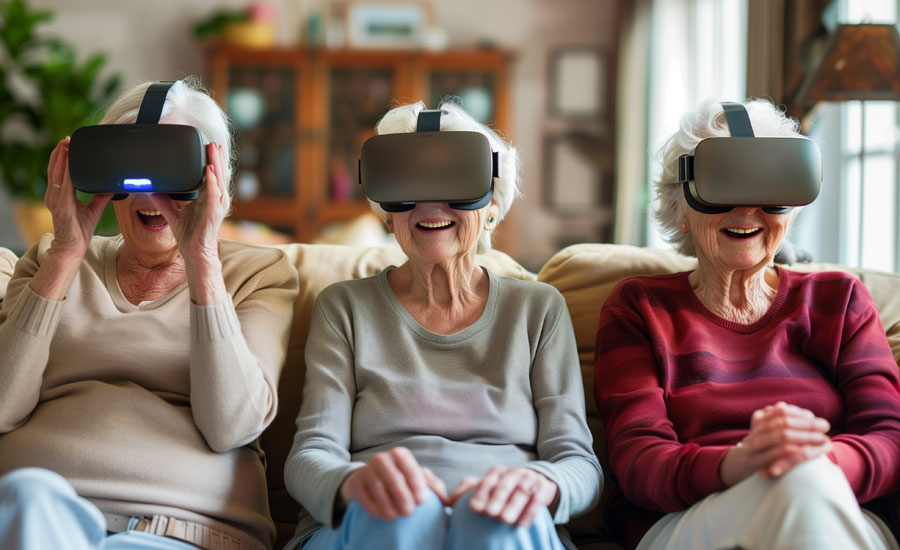The Top Tech Trends Making Care Homes Smarter and Safer

Technology is revolutionising how care homes operate, creating safer spaces and enriching resident experiences. What once relied solely on human effort is now supported by smart systems, innovative tools and data-driven insights.
But how is technology improving care in residential homes?
We’ll explore the latest tech trends making care homes safer and more streamlined and see how they improve life for residents and staff.
How is Technology Improving Care in Residential Homes?
Technology enhances care in residential homes by:
Improving Safety
Residents can attach wearable devices comfortably to their body or clothing, like smartwatches, to track heart rate and oxygen levels and alert caregivers to potential issues. Installing in-room sensors can detect falls and unusual movements, allowing for immediate responses to emergencies and enabling proactive care.
Increasing Independence
Technology in care homes is used to enable residents to manage daily tasks while maintaining dignity and autonomy. Voice-activated assistants like Amazon Alexa or Google Nest allow residents to control lights, thermostats and reminders with simple voice commands.
Supporting Health
Telehealth systems support healthcare in care homes by providing virtual consultations with doctors, reducing the need for trips to clinics. Predictive analytics from health-monitoring devices analyse patterns in data to help carers spot potential risks like infections or worsening chronic conditions early.
Boosting Engagement
VR in care homes provides immersive experiences, like touring beloved locations and playing therapeutic exercises and games, stimulating memory and reducing isolation. Interactive apps like memory training games let residents stay mentally active and socially connected.
Streamlining Care
Digital platforms centralise resident records, making it much easier for care staff to update health data and track care plans in real-time. Automated medication dispensers ensure residents take their prescriptions correctly and on time, reducing human error.
Enhancing Nutrition Management
Technology is making it better for care homes to provide the exact nutrition a resident needs. Apps and systems now help staff track what residents eat, flagging things like low calorie or nutrient intake. For those with conditions like diabetes or swallowing difficulties, tech can ensure meals are safe while meeting health requirements.
Key Tech Trends Elevating Elderly Care
Here are the latest trends reshaping the future of residential care:
Smart Monitoring
- Health trackers and smartwatches monitor heart rate, oxygen levels and sleep patterns.
- In-room motion sensors detect falls or inactivity and alert caregivers instantly.
- Bed and chair sensors track movement to prevent pressure sores and monitor restlessness.
Virtual Care Solutions
- Telehealth platforms allow residents to consult doctors remotely via video calls, reducing travel stress.
- Devices like smart stethoscopes and thermometers enable detailed assessments during virtual visits.
- Chronic conditions, like diabetes, are managed through connected health apps for better oversight.
Interactive Therapies
- Virtual reality headsets let residents explore calming environments, revisit meaningful locations or play interactive games.
- Cognitive apps offer memory exercises and brain-training games to maintain mental sharpness.
- Group VR sessions foster social connections, reduce loneliness and improve mental health in care homes.
Intelligent Mobility Aids
- Smart walkers and wheelchairs with sensors assist with navigation and obstacle avoidance.
- Some devices track activity levels and encourage light exercise to promote mobility.
- GPS-enabled wheelchairs enhance safety by alerting staff if residents leave safe zones.
Robotic Helpers
- Companion robots like Paro the Seal provide emotional support, responding to touch and voice cues.
- Service robots deliver medication, meals and reminders, easing the workload on staff.
- Rehabilitation robots guide residents through gentle exercises to improve strength and flexibility.
Connected Living Spaces
- Voice-activated assistants help residents control lights, thermostats and reminders.
- Motion-activated lighting improves nighttime safety by reducing the risk of falls.
- Automated climate controls adjust the temperature for resident comfort based on preferences.
AI for Personalised Care
- AI in care homes analyses health data to predict risks, like infections or mobility decline, allowing for early intervention.
- Systems adapt care plans based on resident behaviour patterns or health metrics.
- Alerts flag potential issues, such as missed medications or signs of dehydration.
Social and Community Platforms
- Custom apps boost social life in a care home and connect residents through virtual group activities, like book clubs or fitness classes.
- Video calling platforms keep families engaged, strengthening emotional connections.
- Online interest groups foster a sense of belonging and reduce isolation.
What Are The Challenges?
While technology is improving care homes, it isn’t without its hurdles. Here are some challenges we need to be aware of:
- High upfront costs, ongoing maintenance and balancing affordability.
- Ensuring tools are user-friendly for those with cognitive or physical limitations.
- Providing thorough training and ongoing support to integrate tools effectively.
- Protecting sensitive data and complying with GDPR regulations.
- Maintaining a balance between automation and human connection.
- Ensuring new and existing systems work seamlessly together.
- Regularly update tools to avoid outdated tech and keep it effective.
Redefining Care with Technology.
From health monitoring and virtual care to robotics and personalised tools, tech is clearly making care homes safer, more smooth-running and more enriching for residents.
As care homes continue to embrace these advancements, they’re keeping up with the times and setting new standards for quality care. By finding the right balance between innovation and human connection, care homes can make sure every resident lives a fulfilling and happy life.
Ready to explore...
